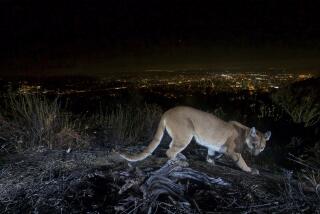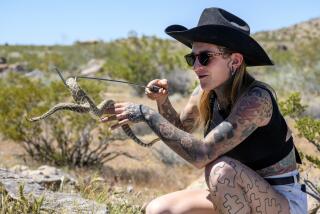Wildlife Brought to School : Getting a Feel for the Furry, Feathery, Scaly
- Share via
A low rumble of excitement rippled through the crowd, erupting into noisy delight as Blanca Simmons walked among the 300 pupils, a nine-foot-long python wrapped around her body.
The children reacted with a chorus of screams as Millicent Wood explained that the snake was not poisonous and, contrary to popular myth, would not devour them with one swallow.
“Our specialty is teaching children about wildlife and the environment through hands-on, guided self-discovery with live animals,” said Wood, 30, a wildlife rehabilitator and animal-behavior specialist who has been working with exotic and domestic animals for 12 years.
Wood and Simmons turned the playground at McKinley School in San Gabriel into a giant classroom during a 45-minute presentation by Wildlife on Wheels, a nonprofit program established four years ago by Wood and David Churchman to acquaint schoolchildren with wildlife they might otherwise never see. After a short break, the same program was repeated for another 300 children.
Keeping Hands Off
Keeping the excited elementary school pupils from reaching out to pet a furry little fox or pulling the feathers of a horned owl was not an easy job, but Simmons, 20, a zoology major at Cal Poly Pomona, managed firmly but politely to elude hundreds of grasping hands.
Meanwhile, Wood interspersed discipline with information, telling the squealing youngsters to quiet down while she explained the animals’ origins, habits and habitat and answered a wide range of questions from the 6- to 11-year-olds.
The high point of the afternoon came when eight youngsters were selected from scores of eager volunteers to actually hold the coiled snake and stretch it out to its full length.
The lucky eight formed a line, hands and arms outstretched, and slowly unrolled the snake.
“It felt kind of heavy, soft and a little gooey,” said Jennifer Phan, 9, a third-grader.
“It felt kind of gross,” declared Adriana Vizcaino, 11, a sixth-grader who helped out.
Look but Don’t Touch
During the presentation, the youngsters could look at but not touch the snake, an iguana, a South American fox, a horned owl and a multicolored toucan.
Wood keeps a wide variety of small wild and domesticated animals--including salamanders, tarantulas, raccoons, a wallaby, a ferret and a mongoose--at the two-acre Wildlife on Wheels compound near Los Angeles International Airport.
But she selects only a few for each presentation. Some, like the timid wallaby, stay home all the time, too nervous to mix with squealing children.
The group speaks to 25,000 to 30,000 students a year in Los Angeles, Orange and Ventura counties. Presentations are given at schools, summer day camps, scout camps and libraries and in conjunction with plays and concerts.
During the 1985-86 school year, the group visited more than 70 schools, Wood said. At Allendale Elementary School in Pasadena, Wildlife on Wheels held a 10-week in-class life-science series, and at Monterey Hills and Marengo elementary schools in South Pasadena the group participated in science fairs.
Wildlife on Wheels charges $150 for an assembly presentation and $30 per class for a three-day-a-week, five-week in-class series. The group works on a budget of about $75,000 a year, which goes to feed and shelter the animals and to pay Wood and Churchman, who handles administrative chores, and the animal handlers.
Most of its funds come from the fees, but the organization also receives private donations and grants, including a recent one from the National Science Foundation.
Wildlife on Wheels presentations are designed to fit into school curricula.
Conservation Stressed
“We stress habitat, behavior and conservation and these particular animals’ roles in the balance of nature,” Wood said, adding that the organization concentrates on elementary schools because “that’s where the attitudes and myths are being shaped.”
Wood said she is particularly interested in debunking some of the frightening stereotypes about wild animals conveyed on television and in literature and motion pictures.
She said that snakes, spiders and wolves are commonly miscast as aggressive and attack-oriented animals when in fact they generally attack only when provoked or if they are starving or badly frightened.
“They don’t attack people for pleasure. Only humans do that,” she said.
Wood said she gets her animals through several channels.
Takes in Animals
As a state-licensed rehabilitator, she is on the U.S. Forest Service’s list of people to whom young animals who have been lost or abandoned in the wild are brought.
U.S. Customs workers sometimes bring her exotic animals that have been brought into the country without proper permits. Some people bring her exotic pets because they have neither the facilities nor specialized knowledge to deal with the animals.
“I’m a softie,” she said. “Even if we’re full, if that animal has no other place to go, I’ll take it and keep it.”
Some of the animals are rehabilitated and returned to their natural habitats. Others that are too domesticated to be sent back into the wild are kept and trained for the program.
Wildlife on Wheels came to the attention of McKinley administrators after pupils there saw a presentation at the Los Angeles Children’s Museum and asked administrators if it could be featured at the school’s annual Good Guy Assembly, where pupils are rewarded for good behavior.
‘Outstanding Job’
“I thought she did an outstanding job,” said McKinley Principal Susan Crum. “She was able to explain things in words that children could understand.
“It was exciting for the animals to come to them, because the only contact these kids have had with most wild animals has been at field trips to the zoo. I think they will remember it and have a better understanding and respect for wild animals from now on.”
“This was one of the best assemblies,” said fifth-grader Amy Thompson. “I learned a lot about the iguana and that hanging neck thing (its dewlap, a loose fold of skin hanging from the throat) he uses to eat,” she said.
After the assembly, groups of third-grade boys debated which animal was their favorite. Most of them voted for the snake. But at least one opted for another animal.
“I liked the fox because it was so small,” said Alex Alvarez, a sixth-grader.
Multiple Degrees
Wood, a specialist in the behavioral biology and psychology of animals, has degrees from the University of California, Davis, and California State University, Dominguez Hills. She was an assistant curator of animal education at the Atlanta Zoo before she set up Wildlife on Wheels.
Visibly tired after her workout at McKinley, Wood said that she thinks her presentations take more energy than classroom teaching “because you’re having to control huge groups of kids and teach at the same time.”
The next day, Wood and her menagerie would go off to a school in Culver City, where Wildlife on Wheels is holding an in-class series. The same week, she would present an assembly at a school in the San Fernando Valley.
She stressed that her main interest is in educating children, not entertaining them.
“The most important thing to remember is there are no animal tricks here,” Wood said. “This is not a circus or a zoo. We show and tell the kids what these animals do naturally in an ecological surrounding. Our animals don’t ride by on bicycles.”
More to Read
Sign up for Essential California
The most important California stories and recommendations in your inbox every morning.
You may occasionally receive promotional content from the Los Angeles Times.










